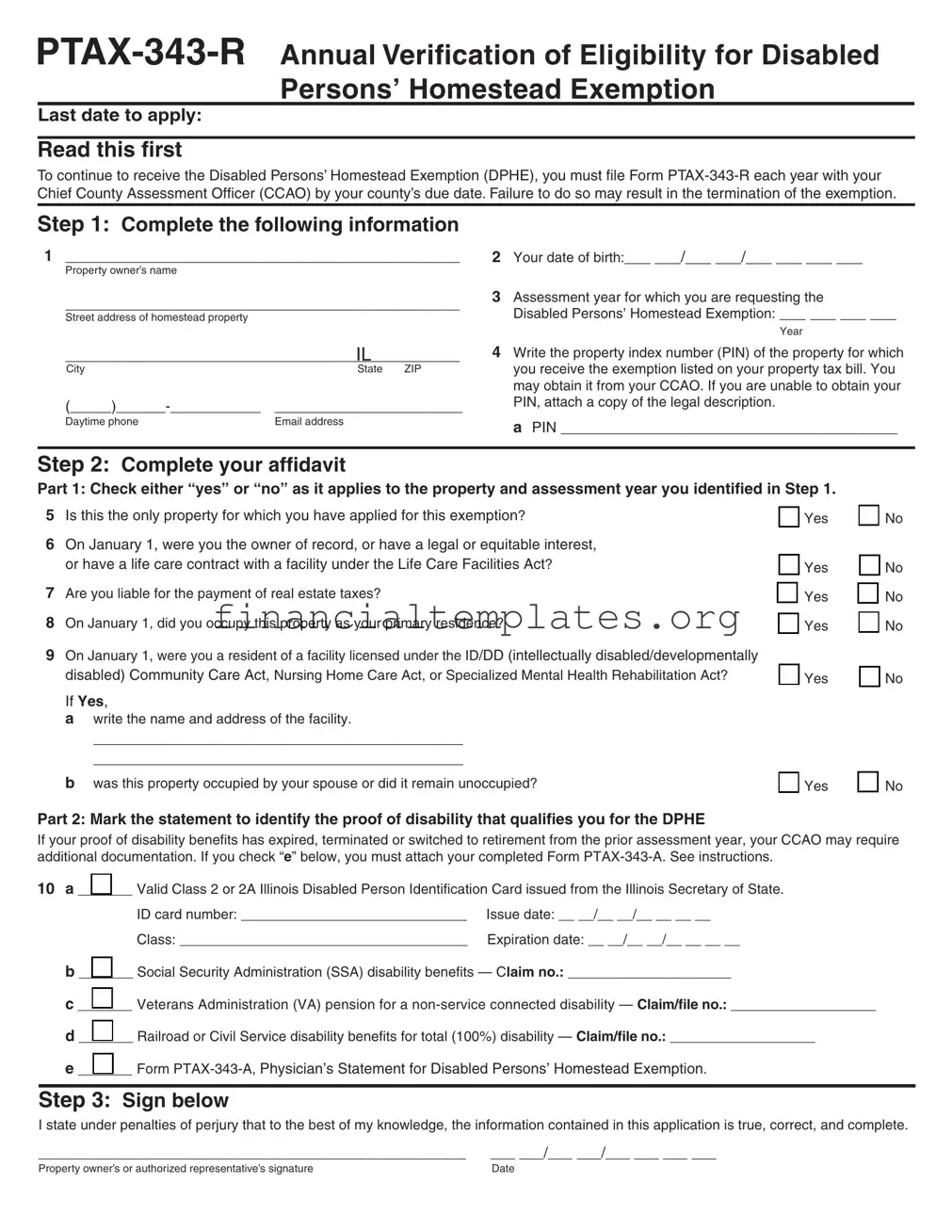The Form PTAX-343-R, which serves as an annual verification for the Disabled Persons’ Homestead Exemption, shares similarities with other documents aimed at confirming eligibility for various exemptions or benefits. One such document is the homestead exemption application used in other states, which homeowners must submit to qualify for a reduction in their property taxes. Although the specific requirements can vary by state, the core purpose of establishing a homeowner’s eligibility for tax relief based on their residency status or personal circumstances, such as disability, mirrors that of the PTAX-343-R, emphasizing the need for regular submissions to maintain the exemption.
Another document resembling the PTAX-343-R is the application for a property tax freeze for senior citizens. This form also requires annual submission in certain jurisdictions and asks applicants to verify their age, income, and status as the property's primary resident. Like the PTAX-343-R, it is designed to provide financial relief to a specific group by reducing the property tax burden, though it targets senior citizens based on age and income rather than individuals with disabilities.
The Veterans’ Disability Exemption form, which veterans with disabilities must fill out to receive property tax exemptions, also parallels the PTAX-343-R. Both documents require evidence of the applicant's status—disability in the case of PTAX-343-R and military service-related disability for the veterans’ exemption. Applicants must provide proper documentation annually or as required to prove their continued eligibility for the benefit, highlighting the importance of sustaining support for those with recognized needs.
The Social Security Disability Insurance (SSDI) benefits application process shares similarities with the PTAX-343-R form in terms of demonstrating eligibility based on a disability. Applicants for SSDI must provide extensive documentation proving their disability and how it affects their ability to work, much like how PTAX-343-R applicants must demonstrate eligibility for the homestead exemption due to their disability status.
Applications for reduced fare or paratransit services for persons with disabilities offered by public transit authorities also echo the PTAX-343-R form's purpose and process. These forms typically require yearly submission along with proof of disability, paralleling the annual verification necessity of the PTAX-343-R to ensure the individual still qualifies for the exemption based on their disability.
The Low-Income Housing Tax Credit (LIHTC) application requires individuals to verify their income annually to maintain eligibility for affordable housing. While focused on income rather than disability, this process mirrors the PTAX-343-R’s yearly verification requirement, ensuring that only those who meet specific criteria benefit from the program designed to aid them.
Lastly, the application for the Supplemental Nutrition Assistance Program (SNAP) shares commonalities with the PTAX-343-R in terms of needing to regularly establish eligibility. SNAP applicants must periodically provide updates on their income and household situation, similar to how recipients of the Disabled Persons’ Homestead Exemption must annually verify their eligibility through the PTAX-343-R, reinforcing the ongoing nature of such support programs.
Each of these documents, while tailored to different exemptions, benefits, or services, fundamentally serves a similar purpose to the PTAX-343-R form. They require individuals to provide current information to confirm their continued eligibility for a specific benefit, reflecting a broad principle across various forms of assistance: maintaining accurate and up-to-date records to ensure that aid reaches those who genuinely qualify.



 No
No No
No